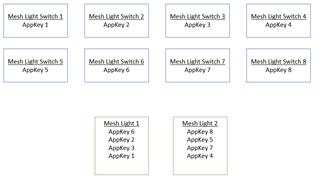Hi!
I want to be able to configure my nodes (assign AppKeys) from my own mobile application. I would like to know if it was posible to provision the nodes from the nordic app (as I always do) and then configure the nodes adding, deleting or changing the AppKeys from my own mobile application. You may wonder why self configure, when there is nrf mesh provisioning mobile app, but it is necessary in order to make an interface for the customers. I have represented a "graphic" example with light/switch from nordic sdk what I want to do.

For example, the app I would like to developed should be able to change Mesh Light Switch 6 controlling Mesh Light 1 to control Mesh Light 2
My questions are:
- Can I do the provisioning process with the nordic app and the appkey configuration with my app?
- If I change an AppKey configuration with my app ¿does the nordic app update itself because of that change in the mesh?
My idea was that the application connect with a proxy node via conventional bluetooth and send the neccesary packages to change the appkey configurations.
- Do you know of any good source of information that talk about how to send these packages?
- If this is not the correct way, how should I implemented?
I'm sorry if I haven't expressed myself well. Thanks for your time.

